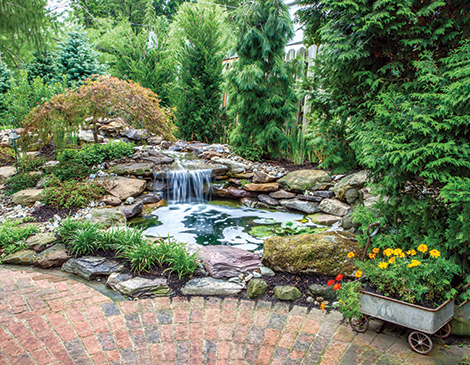The 187-year-old town of Hudson looks like a location Disney might use to shoot a movie set in a kinder, gentler America — a picture-perfect kind of place where residents expect to enjoy peace only broken by the occasional sound of a lawnmower. But appearances can be deceiving, as one couple discovered.
According to David Thorn of Chagrin Falls-based DT Design & Project Management, they could hear traffic on a busy nearby street whenever they ventured into the shady backyard of their white clapboard-sided colonial. “They wanted a place where they could find respite, be transported from their very busy professional careers to a place where they could just feel like they were in an environment that was soothing and out of the hustle bustle of life,” he says.
To create that relaxing retreat, Thorn used the length of their half-acre property’s back lot line to build a naturalistic 15- to 20-foot-long stream that flows over a waterfall into an 8-by-15-foot koi pond. The feature not only muffles traffic noise — it serves as a focal point that puts the typical trickle of water into a pothole-sized pool to shame.
SUGGESTED: 12 Outdoor Design and Patio Trends for Cleveland Homes

To build the stream, workers dug down to the solid-clay soil base to create the bed. They covered the bed with a layer of sand, then a specially designed cushioned fabric, before topping it with a heavy rubberized liner — a construction that prevents the rocks laid on top of the liner from puncturing it. The 2-foot-deep koi pond was constructed in the same manner.
“Before each rock goes down, you cut pieces of additional liner to create more cushion under the heavy rocks so there’s no ability for them to puncture the liner,” Thorn adds. He covered the liner with oversized moss rock, a commercially collected sandstone with moss and lichens growing on it, to create the stream bed and pond bottom’s nature-made look. “I chose a horizontal [slab] shape because that’s more of what you find in an Ohio riverbed.”
Rocks were cantilevered over the pond’s perimeter to fashion an organic shape and stacked vertically along its sides.
The bottom was covered with thin rock and gravel. A ledge-covered pocket provides the koi with a place to hibernate throughout the winter and protect themselves from predators.
“For birds and herons that love these manufactured ponds, [they’re] like a dinner spot for them,” he says.
Thorn tapped into the lawn’s irrigation system to fill the feature, installed an auto-refill mechanism to maintain the water level, and tucked a pump in a rock-covered chamber off the pond. Contractors ran an underground electrical line from the house and connected it to an outlet on a nearby post to power it. The pump sends water through an underground rubber tube to a lidded filter box with an exit pipe buried at the top of the stream.
“There’s a continuous circulation of this water, and it’s constantly being filtered every time it runs to the top of the stream,” Thorn says. “It’s best to let it go all the time except in the wintertime when you shut it down.”
Thorn added a mix of waterlilies, water lettuce and floating hyacinths to the pond and planted the stream banks with masses of perennials native to water zones — iris, astilbe, liriope, ostrich fern — that conceal water-feature components and create “bold brushstrokes of color and shape.” He compares the technique to how trees propagate.
SUGGESTED: How to Make an Environmental Difference in Your Own Cleveland Backyard
“They self-seed in groups — wherever the seeds fall from the tree, that’s where the newest trees [grow],” he says.
The result is a water feature that looks as idyllically good as it sounds.
For more updates about Cleveland, sign up for our Cleveland Magazine Daily newsletter, delivered to your inbox six times a week.
Cleveland Magazine is also available in print, publishing 12 times a year with immersive features, helpful guides and beautiful photography and design.




